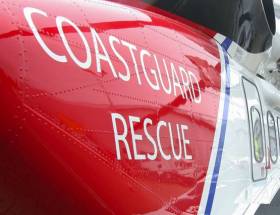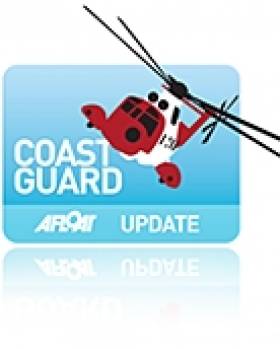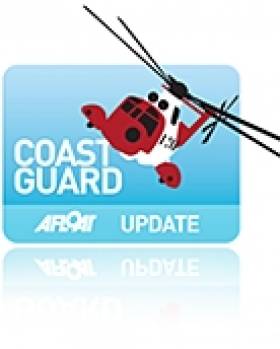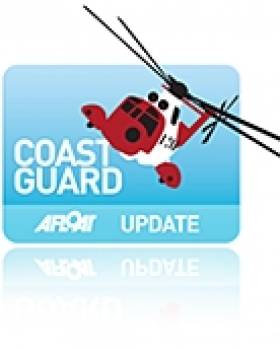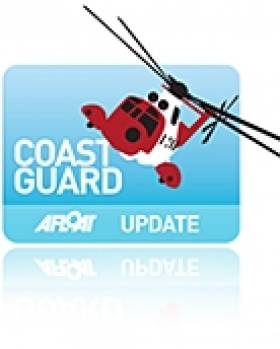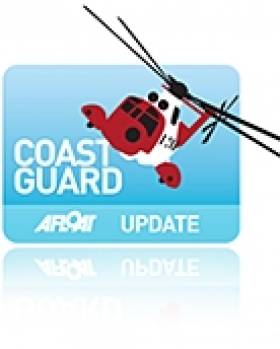Displaying items by tag: SAR
#Search - One crew member from a fishing vessel has been rescued as the search continues for three others after the boat sank off Scotland's Western Isles in the early hours of this morning (Saturday 9 April).
The UK Coastguard received a distress alert just before 3:45am when the fishing vessel with four crew on board has its emergency positioning beacon (EPIRB) activated near Mingulay.
The coastguard search and rescue helicopter based at Stornoway has since been searching the area along with the Barra RNLI lifeboat.
One crew member has been taken to hospital by the helicopter. The lifeboat remains in the area and the coastguard helicopter from Prestwick has taken over so the search can continue.
Waterford Airport Coastguard Celebrates Ten Years
#COASTGUARD - The Irish Coast Guard marked the 10th anniversary of search and rescue (SAR) operations at Waterford Airport recently.
As Waterford News reports, Irish Coast Guard director Chris Reynolds spoke at the special event on 10 May, commending the Waterford helicopter crew for their "very courageous work in often difficult flying conditions" and "their ongoing efforts to make us safer on land and water".
Reynolds also paid tribute to the crew of Rescue 111, which went down in dense fog in the sand dunes at Tramore beach while returning from a rescue mission on 2 July 1999.
The evening also marked another anniversary, with the current Sikorsky S61 rescue helicopter just completing its 50th year of flying.
Reynolds confirmed that it will be retired next year and replaced by one of the new custom-fitted S92 helicopters under the service's €500 million deal with CHC Ireland.
Meanwhile, the Waterford base chief pilot Dara Fitzpatrick thanked the public's support for the service over the years, and especially when planned cutbacks threatened to restrict operations to daylight hours.
"We were thrilled with that support," he said, "hey came out and said no, the service can't go, and we will also be eternally grateful for that."
Waterford News has more on the story HERE.
Coastguard Helicopter Gets State-Of-The-Art Imaging Systems
#COASTGUARD - Canada's L-3 Wescam has announced it will be providing electro-optical and infrared imaging systems for the Irish Coast Guard's revamped search and rescue helicopter fleet, starting with the new Sikorsky S-92 based at Shannon.
“This order pairs the most modern SAR helicopter with the most advanced EO/IR sensor to provide a vital capability for lifesaving missions,” said Paul Jennison, vice president of government sales and business development for L-3 Wescam.
The company describes its MXTM-15 system as a one-line replacement unit solution, which reduces installation weight by 25% and increases much-needed cabin space for transporting rescue victims.
The system’s digital infrared camera is capable of a 20% increase in visual range, allowing missions at night or in inclement weather to result in a higher search success rate.
In addition, the system comes with WESCAM’s MX-GEO Gen 3 software package which helps deliver maximum geographic location accuracy and significantly reduces operator fatigue that often arises in demanding and stressful SAR operations.
Imaging system upgrades are expected to be rolled out across the Irish Coast Guard's helicopter fleet by the end of next year.
New SAR Exhibition at Cornwall Maritime Museum
#SAR – Force 10 storm, zero visibility, 40ft waves, someone needs rescuing. It's time to go to work. Search and Rescue, the new blockbuster exhibition from National Maritime Museum Cornwall invites you to enter the world of the rescue services where ordinary people lead extraordinary lives, risking their life to save yours.
Opening on 16 March, the exhibition takes you on an interactive, stimulating and emotive journey into the role of the maritime rescue services, celebrating the work of the RNLI, Royal Navy, Royal Air Force, HM Coastguard and other organisations.
Objects of epic proportions include a 70ft Sea King helicopter, kindly loaned by the MOD, one of the Museum's most ambitious installations. Uniquely painted in the colours of both the Royal Navy and RAF Search and Rescue (SAR) services (red and grey one side and yellow on the other) it offers you the rare opportunity to climb inside, without having to be rescued. Dress as a pilot, listen to accounts from the crew and from those that have been rescued, explore their lifesaving equipment and discover the world of the Royal Navy and RAF SAR teams.
Revisiting rescues from the past, some well-known and some untold, this exhibition showcases the individuals whose job it is to head into the eye of the storm, when most of us would flee. The exhibition traces the evolution of rescue equipment from the early days of Henry Trengrouse's rocket line to the cutting edge equipment of today and shows that although the equipment might have changed, the determination and grit of rescue men and women to save lives has never changed.
At the heart of the exhibition is an interactive coastguard operations room. Put yourself in the coastguard hot seat, make the life or death decision to bring in the right service for the rescue and begin your journey through the incredible work and lives of the coastguard rescue, air and sea rescue teams.
Get up close to one of the Royal National Lifeboat Institution (RNLI) Atlantic 75 inshore lifeboats and see a fascinating assembly of the charity's collection boxes spanning 150 years. Take to the beach and become a virtual lifeguard, climb aboard a quad bike and take action to make sure the swimmers and surfers are between the right flags. See real seaside rescues and listen to accounts from volunteer crewmen and women.
Ben Lumby, Exhibitions Manager of National Maritime Museum Cornwall, says: "This is our biggest and most ambitious exhibition to date but more importantly it is the first time anyone has celebrated the maritime rescue services in this way."
"Working with these incredible teams has been a true privilege; they have kindly allowed us to see inside their world and shown us they're real people doing an amazing job. They belong to different organisations and charities but work as a team and you can be safe in the knowledge that if things do go wrong at sea, there's a service that will be there for you."
The new Search & Rescue exhibition at National Maritime Museum Cornwall opens on 16 March. Honouring the work of the heroic men and women who risk their lives at sea and around our coast, it invites you to be part of their world and shares their lives with you.
Throughout the two year life of the exhibition there will be a number of events including air sea rescue demonstrations, 'meet the crew' days and opportunities to climb aboard an RNLI all-weather lifeboat. To keep up to date with what's on when, visit www.nmmc.co.uk
New Helicopter for Irish Coast Guard is Completed
#COASTGUARD - Sikorsky has completed production of a new S-92 helicopter for the Irish Coast Guard under the rescue service's €500 million deal with CHC Ireland.
The US-based helicopter firm and CHC formalised the purchase on Wednesday (21 December) with Irish Coast Guard director Chris Reynolds during a hand-over ceremony at the S-92 commercial helicopter assembly facility in Coatesville, Pennsylvania.
Equipped for dedicated search and rescue (SAR) operations, the helicopter will provide coverage for deep Atlantic Ocean missions, service Ireland's offshore islands and provide rescue cover on the west coast from Cork to Galway.
The new aircraft will be based at Shannon and will replace the current coastguard SAR helicopter, a Sikorsky S-61, which has given 20 years of unbroken service.
According to Sikorsky, the S-92 is equipped with advanced systems and hardware, including an automated flight control system that enables the pilot to fly pre-programmed search patterns and perform delicate hover manoeuvres; a wireless intercom allowing a rescue swimmer to communicate with the crew; radio transceivers to communicate with ships and rescue services; a weather radar and infrared sensor; and a digital video system to record rescues.
Reynolds said the new helicopter - which joins four second-hand machines on a 10-year lease - represents a stepped improvement in Ireland's ability to care for and service its seagoing, coastal and island communities.
"I am very happy that the Coast Guard will operate what I consider to be the leading SAR helicopter in the world," he added.
As reported earlier this year on Afloat.ie, the new chopper is part of a deal that raised questions from a Fine Gael TD over allegations that a competing tender did not have a "good reputation".
Fergus O'Dowd questioning the contract with CHC Ireland after receiving documents in which Chris Reynolds said the Air Corps – whose helicopters are supplied by AgustaWestland - were uneqipped for the role and that no cost saving would be made if they took on the service.
Award for Helicopter Crews 'Outstanding Service' to Irish Maritime Search and Rescue
One of the world's leading helicopter services company, CHC has built up an unparalleled reputation for excellence in SAR aviation over 20 years of operations for the Irish Coast Guard.
The tireless efforts of the team, who provide a 24-hour a day service from their Shannon base, has seen them awarded a special Directors Award for Outstanding Service to maritime search and rescue in Ireland.
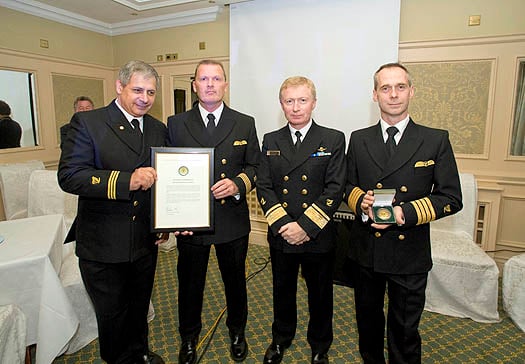
Top Brass: (from left to right) Paul Truss, Eamonn O'Broin, Chris Reynolds and Liam Flynn
The award recognises the personal commitment of all the crews, engineers and staff that have, over a period of two decades from 1991 to 2011, significantly enhanced Ireland's ability to affect a successful rescue and saved many lives.
It was accepted by Shannon Chief Pilot Captain Liam Flynn, Chief Crewman Eamonn O'Broin and Base Manager Paul Truss. Director of the Irish Coast Guard, Chris Reynolds, presented the award at a screening of a television documentary about the unit in Ennis.
The programme, called Rescue 115, will be aired on Irish channel RTE and will give people the opportunity to get an intimate view of what the crew does.
Mark Kelly, managing director of CHC in Ireland, said: "I would like to extend my heart felt congratulations to each and every member of the Shannon team past and present on the Directors Award in recognition of outstanding service to the State.
"The Directors Award is a very prestigious award which has only been given eight previous times.
"In presenting the award at the premiere of Rescue 115, Chris Reynolds spoke of the outstanding service given by the Shannon base and its staff to the State over the last twenty years, during which time it has carried out 3,732 missions.
"It is a well deserved recognition of two decades of tremendous courage, loyalty and dedication to providing a world class search and rescue service."
Earlier this year, a CHC SAR crew was recognised with a Best of Irish award for their role in successfully recovering the pilot of a light aircraft which crashed in the Irish Sea.
CHC Helicopter is the world's largest offshore helicopter operator and provides civilian search and rescue services in Ireland, the UK, Norway and Australia.
False Alarm for Kitesurfer 'Pulled Out to Sea'
A number of local Search and Rescue Units were involved in the search for a Kite Surfer who was seen being pulled out to sea approximately 3 miles off Balaggan Point, Co Louth yesterday, according to SAR Ireland.
Full CH 67 Comms below.
Kilkeel, Greenore and later Clogher Head lifeboats were all involved along with a passing yacht as they raced in pursuit of what was thought to be an out of control Kite Surfer as he was spotted being pulled out across Dundalk Bay.
Clogher Head lifeboat eventually managed to catch up with the surfer who it turned out was being towed by a jetski, had a VHF handheld and was in no danger whatsoever.
All units were stood down and told to return to base.
Both Belfast and Dublin CG Co-ordinated at different intervals of this search.
Dublin Bay Mudflat Rescue Caught on Video
A Dubliner had a lucky escape after being stranded on mudflats between Baldoyle and Sutton Point, on Dublin Bay last week.
The man had sunk waist-deep in mud on a low tide and was unable to free himself. Dublin Fire Brigade was tasked to the scene along with the Howth Coast Guard unit. The Youtube clip of the entire incident is below.
Rescue helicopter 116, which was already on the ramp at Dublin Airport in preparation for a training exercise, was also tasked at 16.18pm according to a report on the the SAR Ireland blogspot.
After obtaining permission to cross the 'Live' runway at Dublin airport, R116 was on scene within minutes and quickly identified the man who was described as wearing 'dark clothing'. He was quickly winched to safety and returned to Dublin Airport at 16.36pm, where he availed of crew facilities to clean himself down and arrange transport home.
More on Dublin Bay here
New Blog with Streaming Search and Rescue Audio
A new blog has been setup by fans of Irish SAR teams that has the latest SAR info and live audio streams of marine band comms. The latest rescue updates are available on the Twitter hashtag #ircg and the Blog site is irishsar.blogspot.com. Check it out HERE.
Stornoway Helicopter Reports Busiest Year Ever
Scottish Coastguard rescue helicopter based in Stornoway has recorded its busiest ever year after clocking up in excess of 200 callouts in 2010.
It is the first time the rescue helicopter team has reached the milestone figure for missions in any one year, traditionally responding to an average of 136 callouts between January 1 and December 31. Since the introduction of the new technology S92 helicopters in 2007 however this has risen to an average of 190.
Leading search and rescue (SAR) service provider CHC Helicopter has operated the service for the Maritime and Coastguard Agency in the UK since 2007 from four bases at Stornoway, Sumburgh, Lee on Solent and Portland. Through its membership of the Soteria consortium, it has been identified as the preferred bidder on the UK SAR-H program, a 25-year contract to provide helicopter-based SAR services from 12 bases throughout the UK.
Ian McLuskie, UK SAR Business Unit Leader at CHC said: "The past three years have been the busiest we've ever had in terms of callouts and this is due to the capability of the S92 aircraft which are able to fly faster and further than those previously in use.
"This increased operating range and speed allows us to get to locations quicker, the overall result is a reduction in the time taken to rescue and get medical aid to those in need. This has allowed the unit to be called out to a greater number of jobs throughout the year, bringing the search and rescue service to a greater number of people and helping to save many more lives."
The Stornoway unit conducted its 200th mission on December 10th when rescue helicopter R100 was scrambled to evacuate a 57-year-old female who required urgent hospital treatment after experiencing breathing difficulties. The patient was transferred to Raigmore Hospital in Inverness.

